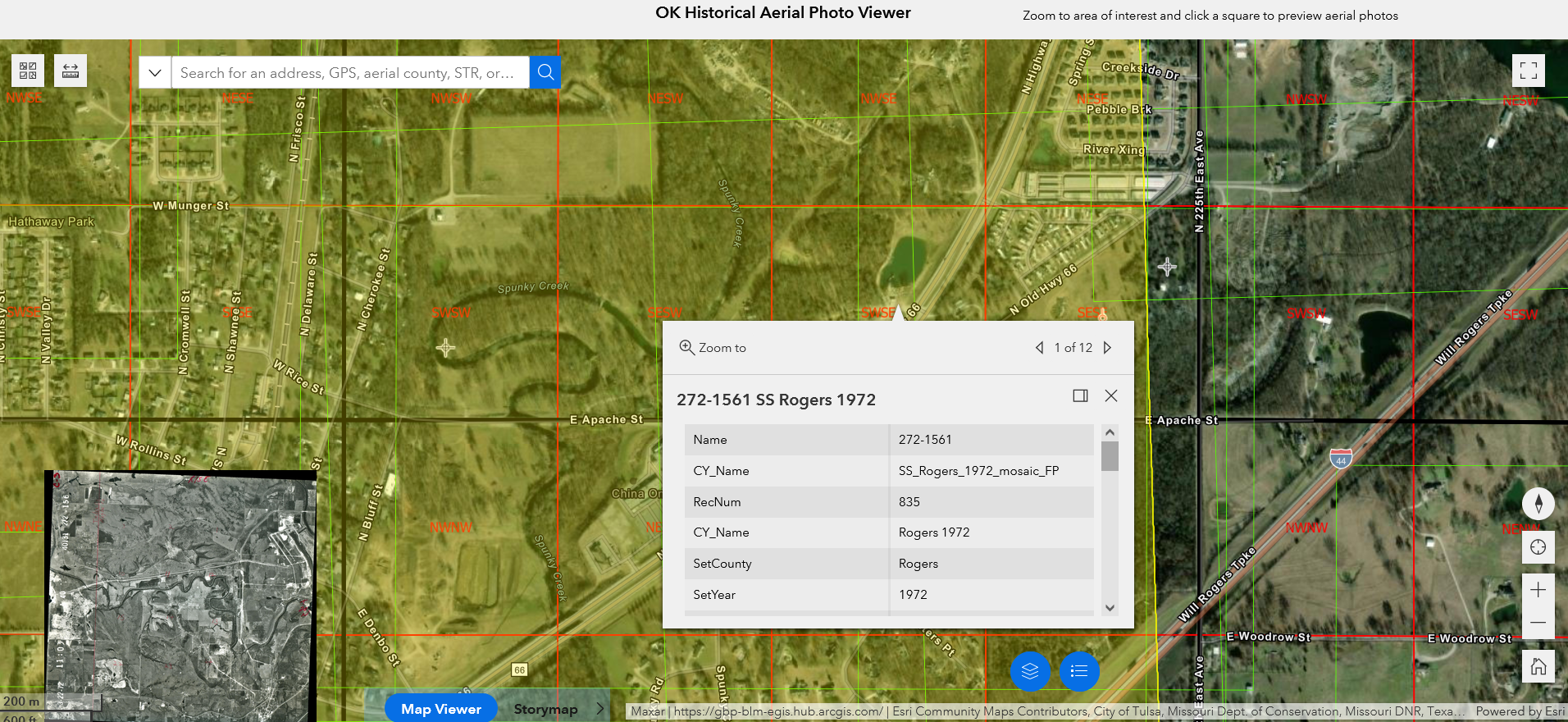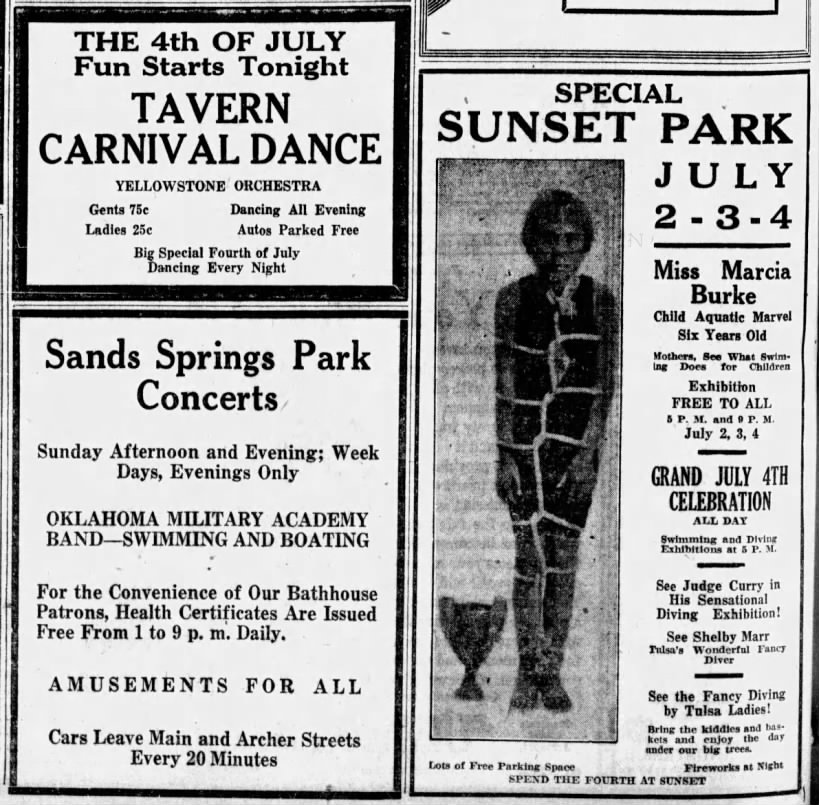Tulsa History: November 2023 Archives
What was here? Who owned it? What did it look like? There are a number of resources available for reconstructing Oklahoma's geographical past, and they're easier to use than ever. These are my go-tos when researching the history of a neighborhood or answering questions about the past. This is an encyclopedic article, so if you're on the home page, you'll have to click the "Continue reading" link to see all of it.

These links will take you to specific sections of this article:
- Oklahoma Historical Aerial Digitization Project: Geotagged historical aerial photos going back to the 1930s
- Oklahoma Aerial Photo Inventory: A broader collection of imagery, including some not yet geotagged
- EarthExplorer: US Geological Survey aerial imagery: Higher resoution aerial photos from the 1950s through the 1970s, plus satellite and other imagery
- topoView: US Geological Survey historical topographical maps: Maps for Oklahoma from 1901
- US Bureau of Land Management Land Records: Township survey plats of Indian Territory from the 1890s, with field notes from the surveyors
- Oklahoma State University McCasland Maps Collection: Includes historical county highway maps as early as 1937, plus USGS topo quads not in the topoView collection
- WPA 1936 land ownership and valuation maps: Interactive statewide browser
- Tulsa Sanborn Fire Insurance Maps at Library of Congress: Building-by-building detail from Tulsa's earliest days through 1915, 1939, and 1962
- Tulsa Census Enumeration District and Census Tract Maps: Base street maps and boundaries of statistical neighborhoods
- Tulsa County Clerk Subdivision Plats and Deed Indexes
- Tulsa County Assessor Static Section Maps
- Miscellaneous Maps of Tulsa
Note: I started on this back on August 20, 2023, meant for it to be a quick blog post, but got bogged down trying to locate some of the places mentioned. It's November 19, 2023, and chilly and rainy outside, but I took a few minutes to finish this up and publish it.
What did Tulsans do 100 years ago to escape the summer heat? Some answers can be found in a little clipping I saved during some research on Tulsa's streetcars and electric interurban railroads, from the June 25, 1923, Tulsa Tribune:
 Picknickers Flock To Woodsy Places As Sol Hits High
Picknickers Flock To Woodsy Places As Sol Hits HighMANY BEAUTY SPOTS NEAR CITY ARE POPULAR
The old picnic basket has been taken off the shelf and dusted in the last few days. New sets of paper plates and napkins have been procured, and a supply of tin cups to be tied on the basket handle.
For summer has come, with Old Sol himself emphasizing the fact every day, and the urge of the cooling breeze, sought in woods and by streams, is stirring the populace.
Every paved road leading out of Tulsa is lined with motor cars and picnic crowds in the afternoons and in almost every direction, a good spot for supper grounds can be found.
If swimming is to be combined with sandwiches, as is generally the case, "Katy" lake, near Alsuma, which is reached by driving out the Broken Arrow road to the big brick house, which is about half way, and then driving down the dirt road for several miles, is one of the most popular.
Owasso lake, which can be reached by pavement as far as the town itself, has always been an attractive place for swimmers, and Hominy Falls has occasionally been selected by those who do not mind a long drive.
Fishing parties generally choose the Verdigris river, and a stream two miles south of Leonard is drawing groups of boys and men for week-end trips. Shell creek dam, beyond Sand Springs, offers the best nearby fishing opportunities.
At Parthenia park is a swimming hole not far from town. It is reached by driving out the Sapulpa road to Oakhurst, then going across the O. U. R. tracks to the lake. Parthenia, and the Oakhurst Country clubs grounds, are usually chosen by picnic parties, too.
A pleasant spot for weiner roasts, and parties who like to climb, is at Lost City, which can be reached by driving out the Sand Springs road, across the bridge to Fisher, then climbing up the hill. Turkey Mountain, out the Red Fork road, is also good for climbing parties.
Mingo Creek is a spot easily reached by driving out Admiral to Lewis avenue, then going north two miles, then east to the creek. Sapulpa lake, on the other side of that city, is good for both swimming and picnicking.
Among places which can be easily reached by those who do not have cars, are Sand Springs park, which the Sand Springs interurban reaches and Sunset and Electric parks, on the Sapulpa interurban line. All three places have swimming pools, concessions, and other amusements.
So where were these places? I could easily do a deep dive on each place mentioned, but I'll limit myself to locating each:
Katy Lake: A classified item in the October 10, 1923, Tulsa World announcing that hunting at the lake was not allowed provides a better description of its location: S 1/2 SE 1/4 S23 T19N R13E. That's an 80 acre tract bounded today by 38th Street, 41st Street, 73rd East Ave, and Memorial. As you'd guess by the name, the lake abutted the old MK&T ("Katy") railroad between Tulsa and Broken Arrow. A story from April of that year announced that it would be renamed Rose Lake and expanded with a 90-foot dam impounding 18 acres, surrounded by pecan groves. News items from later in the year suggest that the Rose Lake name never caught on. A miniature brewery located near the lake was raided and destroyed in a July 1923 raid, but the Katy Lake owner, J. O. Whitman, wanted it known that it was not at his lake. (The accused brewer was named J. H. Stout.)
USGS maps from the early 20th century show a lake straddling the tracks at that spot; the Jenks quadrangle from 1953 shows a string of lakes running all the way to Memorial. Today there's a large, dry stormwater detention area with a channelized Fulton Creek running along its northern edge. As recently as 2003, there was still a lake in the area. The "Broken Arrow road" probably referred to Harvard Ave, which would later be part of Oklahoma Highway 51 and US 64, which ran from 15th to Harvard to 51st Street to Memorial. Traffic for Broken Arrow would head east on 71st from Memorial.
The "big brick house" is probably the two-story house with the green tile roof that sat on a rise northeast of 41st and Harvard. A convenience store was built in front of it, it served as a day care or school for many years, and it was demolished after New Life Center moved to Broken Arrow and sold its building to Freeman Harris Funeral Home in 2001; Cornerstone Church is now located there. Newspapers say the home was built by an unnamed oil millionaire and was later an orphanage. Its final use was as Christian Day Care Center. The house was the original home of and then parsonage and classroom space for Bethany Lutheran Church in 1954, which built a Blaine Imel-designed sanctuary, which was sold to Bethel Temple in 1962. There is a news story from December 19, 1971, that brings together several fascinating threads of demographic displacement. The history of that plot of land and the churches connected with it deserves its own article.
